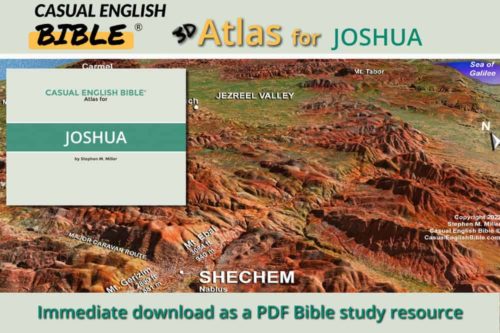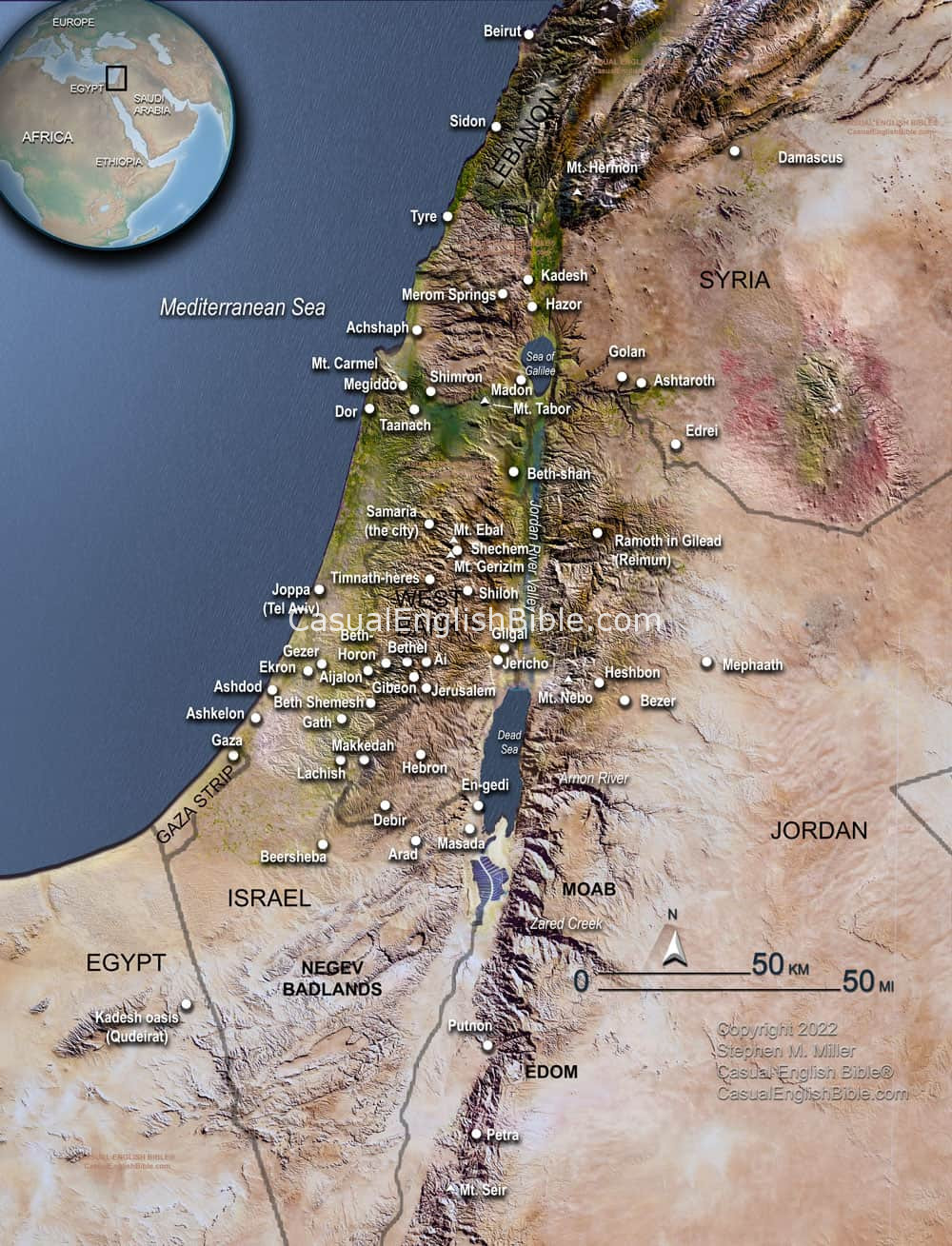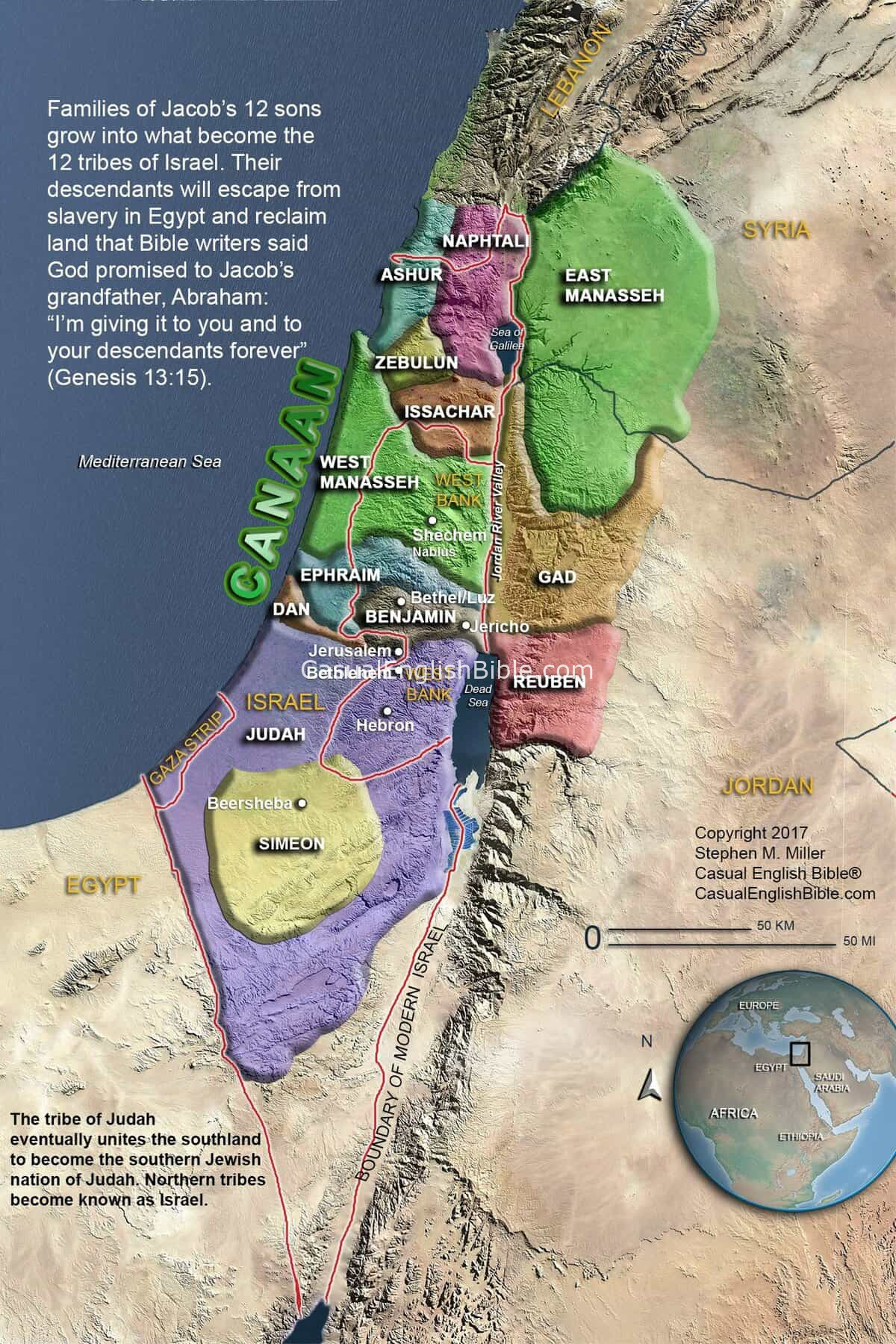Joshua 19
Israel finishes assigning land to tribes
Real estate for Simeon’s tribe
1Israel’s leaders rolled dice [1] to see which tribe should get the second section of land. Simeon’s tribe won the roll. They were assigned an island of land in the center of Judah’s tribe. They were both landlocked and surrounded by Judah. [2] 2Simeon’s cities [3] included:Beersheba (or Sheba), Moladah,
3Hazar-shual, Balah, Ezem,
4Eltolad, Bethul, Hormah,
5Ziklag, Beth-marcaboth, Hazar-susah,
6Beth-lebaoth, and Sharuhen.
That’s 13 towns with their outlying villages.
7There’s also: Ain, Rimmon, Ether, and Ashan.
That’s four more towns with their villages.
8In addition, they owned all the scattered villages and settlements as far south as Baalath-beer, also known as Ramah of the Negev. This is the land assigned to the families of Simeon’s tribe. 9Judah had more land than their people needed. That’s why Simeon’s tribe was assigned territory inside Judah’s boundaries.
Real estate for Zebulun’s tribe
10The second section of land went to Zebulun’s tribe. Their boundary started at Sarid. 11It climbed west to Maralah, brushing Dabbesheth and going on to the dry creek bed near Jokneam. 12From Sarid, it turned east and extended to the land of Kisloth-tabor. It turned up to Daberath and then Japhia. 13Then in ran east to Gath-hepher, Eth-kazin, Rimmon, and Neah. 14It turned north to Hannathon and ended at the valley of Iphtah-el. 15Cities inside Zebulun included Kattath, Nahalal, Shimron, Idalah, and Bethlehem. [4] Zebulum owned 12 towns and their outlying villages 16That’s the land assigned to families in the tribe of Zebulun.Real estate for Issachar’s tribe
17Issachar’s tribe got the fourth section of land. 18Cities included:Jezreel, Chesulloth, Shunem,
19Hapharaim, Shion, Anaharath,
20Rabbith, Kishion, Ebez,
21Remeth, En-gannim, En-haddah, and Beth-pazzez.
22Issachar’s boundary brushes Tabor, Shahazumah, and Beth-shemesh. The boundary ends at the Jordan River.
That’s a total of 16 towns with their villages. 23This is the land assigned to families in the tribe of Issachar.
Real estate for Asher’s tribe
24Asher’s tribe got the fifth section of land. 25Cities on their property:Helkath, Hali, Beten, Achshaph,
26Allammelech, Amad, and Mishal.
Asher’s western boundary brushes against the Mount Carmel range of hills and Shihor-libnath. 27From there, it turned east and continued to Beth-dagon. It brushed Zebulun’s tribal boundary and the Valley of Iphtah-el. Then it went north to Beth-emek, Neiel, and Cabul. 28It included the cities of Ebron, Rehob, Hammon, and Kanah. It reached as far north as Great Sidon.
29The border turned south toward Ramah. It continued to the walled city of Tyre. Then it turned toward Hosah and it ended at the shore of the Mediterranean Sea. Cities in Asher’s tribe also included:
Mahalab, Achzib, 30Ummah, Aphek, and Rehob. There were 22 towns with their outlying villages. 31This is the land assigned to families in the tribe of Issachar.
Real estate for Naphtali’s tribe
32Naphtali’s tribe got the sixth section of land. 33Their boundary started at a huge tree in Zaanannim, by Heleph. It continued on to Adami-nekeb, Jabneel, and Lakkum, before ending at the Jordan River. 34The boundary took a turn west and ran through Aznoth-tabor and Hukkok before brushing the borders of two tribes: Zebulun in the south and Asher in the west. The border ends at the Jordan River. [5] 35Naphtali owned these walled cities:Ziddim, Zer, Hammath, Rakkath, Chinnereth,
36Adamah, Ramah, Hazor,
37Kedesh, Edrei, En-hazor,
38Iron, Migdal-el, Horem, Beth-anath, and Beth-shemesh.
That’s a total of 19 towns with their villages.
39This is the land assigned to families living in the tribe of Naphtali.
Real estate for Dan’s tribe
40Dan’s tribe got the seventh section of land. 41Their territory included the following towns:Zorah, Eshtaol, Ir-shemesh,
42Shaalabbin, Aijalon, Ithlah,
43Elon, Timnah, Ekron,
44Eltekeh, Gibbethon, Baalath,
45Jehud, Bene-berak, Gath-rimmon,
46Me-jarkon, and Rakkon at the border across from Joppa.
47Dan couldn’t capture the assigned territory. [6] So the tribe migrated to Leshem. [7] They conquered the town, renamed it “Dan,” and settled there. 48This was the land assigned to families in the tribe of Dan.
Joshua gets his own town
49After Israel finished dividing the land among the tribes, they gave some land to Joshua. 50The LORD told them to give Joshua what he wanted: the town of Timnath-serah, in the hills of Ephraim’s tribal territory. He rebuilt the city and settled there.51This is how the priest Eleazar, Joshua the son of Nun, and Israel’s tribal leaders distributed the land randomly among the tribes. They did this in the LORD’s presence at the entrance to the tent worship center in Shiloh. The work of dividing the land was finished.
Footnotes
More literally, they were to throw or draw “lots.” The “lots” may have been stones or animal bones marked in a way that produced random outcomes for “yes” or “no” answers, or for determining who goes first in a group. The idea is like throwing dice, with the high number going first or getting selected. They seemed to expect that the LORD would control the selection process and give each tribe the land he wanted that tribe to have.
People in Simeon’s tribe couldn’t go anywhere without passing through Judah’s territory. Judah gradually absorbed the tribe. When the nation split into north and south, people living within the tribal territory of Judah and Simeon took the name of Judah as their nation. The northern nation, with its 10 tribes, kept the name of Israel.
The location of many towns in this and other lists of tribal cities remain a mystery. Tribal boundaries created on maps today are educated guesses based on cities identified with varying degrees of certainty.
Not THE Bethlehem, where Jesus was born in the tribe of Judah. Zebulun’s Bethlehem was in Galilee, about six miles (10 km) northwest of Nazareth.
Oddly, the Hebrew words say the border continued to what some translate as “Judah of the Jordan.” The context, following a reference to the borders of two other tribes, would hint that the writer was talking about the tribe of Judah. But Naphtali was a northern tribe and Judah lived at the southern end of the country. Their borders didn’t come close to touching. A 2,000-year-old Jewish translation of the Hebrew Bible into Greek translated the reference as a “lowland” area by the Jordan River. Some scholars say “Judah” is a mistake that got copied into the text centuries ago, before the birth of Jesus.
Judges 1:34 says Amorites restricted Dan to the hills. Apparently, Dan couldn’t beat them in a battle on the plains, where chariots could run down Israelite foot soldiers. Coastal cities assigned to Dan show up later in the stories of Samson fighting the Philistines who lived there. Dan may have fought them, too. Philistines were strong warriors with iron weapons, fighting Israelites who used bronze weapons. The story of Dan’s migration north shows up in Judges 18.
An early name for what became the northern city of Laish, at the foot of Mount Hermon.
Discussion Questions
- Sorry, there are currently no questions for this chapter.







